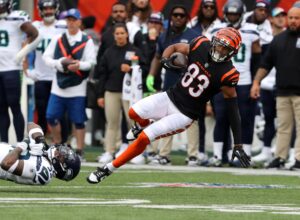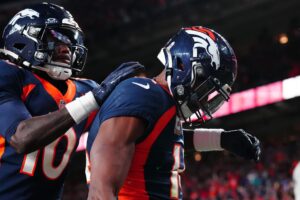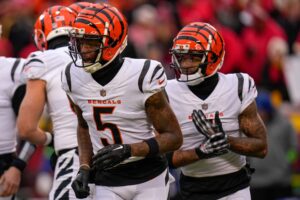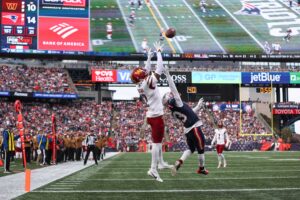Quarterback Drew Brees and the New Orleans Saints passing game have operated at a historic pace this season. Up until Thursday night’s 13-10 loss to the Dallas Cowboys, it seemed impossible to disrupt the efficiency of a quarterback that is on pace to break the NFL’s records for highest completion percentage and highest passer rating in a season.
Yet the Saints offense found its match in a physical, athletic Cowboys defense, which held New Orleans to one of their worst passing performances since Brees joined the team in 2006.
The New Orleans Saints Efficient Passing Game Faltered Against the Dallas Cowboys on Thursday Night Football
How Bad Was It?
Brees’ 64.2 completion percentage, 127 passing yards, and 71.6 passer rating were all season lows, but that only scratches the surface. His 4.54 yards per pass attempt was his lowest mark as a Saint since his 3.87 yards per attempt in a 2013 loss to the Seattle Seahawks. His only other lower average with the Saints was back in 2006.
The Saints 111 net passing yards (passing yards minus yards lost from sacks) was their lowest since a season-ending 2009 loss to the Carolina Panthers when Brees sat out in preparation for the postseason. It was the Saints lowest net passing yardage output with Brees as the starter.
Speaking more broadly, the Saints 176 offensive yards was their lowest yardage total since 2001 and only the second time a Sean Payton-coached Saints team was held under 200 yards.
How the Saints Hurt Themselves
One of the NFL’s best ever head coach-quarterback duos doesn’t get shut down without a great effort and game plan by the opposing defense. I’m not taking any credit away from what Dallas did on Thursday, but the Saints offensive mishaps cannot be overlooked.
Saints receivers dropped five passes in the first 18 and a half minutes of the game. Most of these drops were the result of contested throws, but they were 50-50 balls that Saints receivers have routinely caught this season.
Some of the drops came in critical situations, such as a third-down pass to Michael Thomas in the first quarter that was ruled incomplete, and held up after a Saints challenge. In the second quarter rookie Tre’Quan Smith dropped a potential touchdown pass inside the Cowboys five-yard line, and three plays later New Orleans turned the ball over on downs.
Strategically, it was puzzling how little New Orleans ran the ball early on. At halftime, the Saints had run twice as many pass plays as run plays. Only two of their eight first down plays in the first half were runs. The Cowboys didn’t give them much room to run, but the Saints still averaged a healthy 4.0 yards per carry on seven first-half rushing attempts.
The lack of Saints run plays helped Dallas possess the ball for 13:38 longer in the first half. That’s especially hard to do against New Orleans, who entered the game leading the NFL in time of possession. The frequent passing also allowed Dallas to focus on their pass rush up front, forcing Brees to settle for short passes. The Saints longest completion of the first half went for 15 yards, and the only completion to a wide receiver went to Thomas for just four yards.
How the Cowboys Hurt the Saints
Dallas played almost exclusively man coverage, which can be risky against an offense that capitalizes on mismatches. However, the Cowboys proved they had the size and speed on the back end to match up with the Saints versatile receiving corps. Cornerback Byron Jones, in particular, is one of the few cover men that have matched the excellent route running and physicality of Thomas this season.
The rest of the Saints wide receivers, consisting of two undrafted free agents and one rookie seemed lost in the aggressive Cowboys defensive backfield. The only contribution from them was the 30-yard touchdown reception by undrafted rookie Keith Kirkwood in the third quarter.
This game seemed like a good opportunity to activate veteran receiver Brandon Marshall who is still learning the offense after being signed two weeks ago. Marshall isn’t the playmaker he once was, but the Saints acquired him to be another big, physical presence in the passing game to pair with Thomas. New Orleans certainly needed that in this game.
Rookie linebacker Leighton Vander Esch spent much of the game matched up with Alvin Kamara and proved to be up to the challenge. He rarely let the elusive back get separation or slip away after the catch. Kamara gained just 3.8 yards per pass target against Dallas, his lowest figure since week three of last season.
How Did Dallas Pressure Brees so Consistently?
Up-front, the Cowboys rarely rushed more than four defenders, but their pass rush strategy worked brilliantly. They managed to get consistent pressure up the middle using stunts and by mixing up the defensive tackles’ alignments. Pressure up the middle can be devastating for shorter quarterbacks like Brees, who often struggle to see downfield when there’s congestion up front.
This is why Brees struggled to find receivers crossing the field and downfield for much of the game. It could have also been why he didn’t see cornerback Jourdan Lewis lurking when he threw an interception on his final pass with a defensive tackle in his face.
New Orleans better find a remedy for this type of rush quickly, because every remaining Saints opponent is going to study how Dallas consistently beat the elite Saints offensive line.
Outlook
There are a couple of lasting consequences for this performance. New Orleans lost their NFC lead just one week after moving ahead of the Los Angeles Rams. If Los Angeles finishes the season as the number one seed, it would be a shame to look back and see that a rare Saints offensive meltdown cost them the chance to control their own destiny.
Less importantly but still significant: MVP voters will undoubtedly remember this game when deciding between Brees and the other candidates in the coming months.
The bigger picture though is that the Saints offense hasn’t played this poorly in a long time, and they’re unlikely to do so again this year. The defense played one of its best games of the season, holding Dallas scoreless in the second half, recording seven sacks, and allowing just one score on five Cowboys red zone attempts.
This still looks like the best team in the NFL, and that won’t change unless New Orleans has another ugly offensive performance.
Main Photo:
Embed from Getty Images






